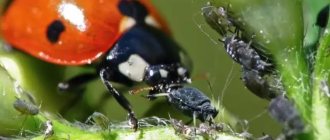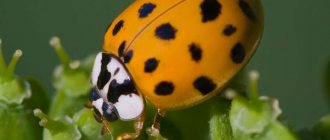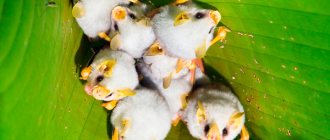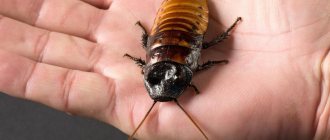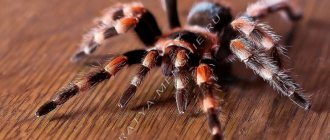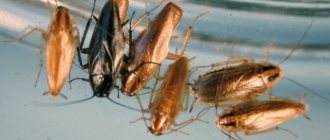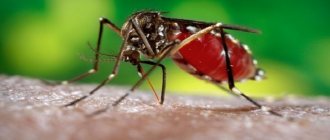What do ladybugs eat? Most are predators and eat other insects, many of which are considered serious plant pests. The ladybug is often called a gardener's best friend. They eat aphids, thereby controlling the number of insect pests in the garden and replacing the use of chemical pesticides. Ladybug larvae also feed on aphids. They also eat other insects that have soft bodies - mites, whiteflies, scale insects and others.
Ladybug: life cycle
There are more than 4,000 species of these interesting representatives of the insect world (Latin name: Coccinellidea) in the world. What do ladybugs eat? Adults and larvae feed on soft-bodied pests, plant mites and egg pests. What they love most is aphids! One individual usually eats more than 5,000 aphids in its life. What is their life cycle? The female lays her eggs (5-20 pieces) on the leaves or stems of plants. After about a week, the eggs hatch into larvae that look like tiny crocodiles. Before becoming a pupa, the larva consumes 350 to 400 aphids.
The larvae go through several stages of maturation. After about a month, the larvae pupate, and a week later young beetles appear. At this stage, they are completely different from the adults that people used to call ladybugs. Their distinctive features are their spots and bright color, which are meant to make them less attractive to any predators.
Interesting facts about ladybugs
- The average life expectancy in the wild is 2-3 years.
- The length of the insect usually reaches 7-10 millimeters.
- To clean its head and antennae, the ladybug uses its front legs.
- As the individual grows, the spots on the flaps become lighter.
- The wing flapping speed is approximately 85 times per second.
- Breathing occurs through openings on the sides of the body.
- A ladybug can hide its head in its body under certain conditions.
- The larvae grow very quickly and change their appearance 3 times.
- In some countries they are considered to bring good luck.
- When ladybugs feel threatened, they begin to secrete a special yellowish liquid that smells unpleasant and is toxic to other insects. This is their kind of defense mechanism. In some cases, they may even pretend to be dead.
- They are welcome guests in any garden, as they feed on garden and garden pests.
- Ladybugs will also live indoors.
What does a ladybug look like?
Some representatives have red elytra with black dots; in nature, orange, black with red dots, and completely brown or black are also found. The body structure includes the head, thorax and abdomen. There are a pair of antennae, a pair of compound eyes on the head, and six segmented legs that attach to the thorax. Under the thick, hard elytra there is an additional pair of thin wings. Different species have different feeding habits. What do ladybugs eat? In nature there are predatory and herbivorous species. Vegetarians in the ladybird family feed on mushrooms and leaves. Some eat insects that eat plants (aphids, midges).
Classification by type
In total, the family unites more than 4000 species, divided into 7 subfamilies, which, in turn, unite 360 genera. You can identify the most interesting and original-looking representatives:
- Two-point. The body length of this beetle is 5 mm. The elytra are dark red and have large black spots. The anterior carina on the prothorax is absent. The front wall has a yellow border on the side, and this part of the body itself is black.
- Seven-point. In European countries this species is the most common. Its dimensions vary from 7 to 8 mm. The elytra are red, at their base there is one white spot of miniature size and 3 larger black spots. A seventh spot is found on the cheek.
- 12-point. This beetle is 6 mm long. The elytra are red or pink, and each of them has 6 dots.
- 13-point. Their body is elongated, the size ranges from 5 to 7 mm. There are 13 spots on the red-brown wings, some of which are combined with each other.
- 14-point. The main color of this species is black or yellow. If the wings are colored yellow, then their points are black, and vice versa. The body has a length of up to 3.5 mm. This species is found in European countries.
- Asian. The length from the head to the edge of the abdomen is 7 mm. There are two subspecies, one of which has yellow wing covers and black spots. They can be small or large in size. The prothorax is white in color and decorated with a black pattern. The second variety has black elytra, on which 19 red or orange spots can be clearly seen.
- Changeable. The body size reaches 5.5 mm. The pronotum is black, decorated with two yellow spots. There is also one large spot near the shield. A yellow border frames the edges of the front wall.
There are other varieties worthy of attention. The ocellated ladybug is a fairly large insect. Its body length can reach up to 10 mm. The head and back in front are black, decorated with yellow dots. The presence of light rims on the elytra is a characteristic feature. Another type is the 24-spot alfalfa, a pest of agricultural crops. The small beetle has a total body length of no more than 4 mm. Its body is red, strewn with 24 small black spots.
The dotted species is considered quite rare. Thin and small villi cover its brown or red body. An adult is rarely larger than 4.5 mm. There are no characteristic points here.
At the same time, several shade variations are provided for the genus Sospita. The Halyzia sedecimguttata variety has an orange body color and many white dots. You can see it in the British Isles and in some European countries. Anatis labiculata is characterized by a light gray or white body color. Halmus chalybeus is a unique blue-colored species native to Australia.
Defenders of crops and ornamental gardens
The ladybug is a member of a family that includes thousands of species of insects. When people hear the words “ladybugs,” they think of bright red beetles with black spots, although these beneficial insects come in a variety of colors, with or without spots. What do ladybugs eat? They live in gardens all over the world and are often welcome visitors as they eat agricultural pests and other small insects.
Males and females of many species are very similar, only biologists can tell them apart. What do ladybugs eat? Typically, after mating in the spring, they produce large clutches of eggs, which are located next to a colony of aphids and other small insects. When the larvae hatch, they can feed on insects until they are large enough to fly and find food on their own.
Interesting to know
Folklorists believe that the name of the beetle is directly related to the ancient Slavic pagan goddess of agriculture and fertility Mokosh. The flight of an insect from the finger was accompanied by the well-known request for bread (“fly to heaven, bring me bread”) as a symbol of productivity and prosperity. This explains her divinity.
Read also: Rat trap made from a plastic bottle video
For some, it is surprising to learn that the ladybug is a predator. They eat insects and their larvae, most of which are pests. The most favorite food of ladybugs is aphids and their larvae. One ladybug can eat more than 6,000 aphids in a year and a half. So these colorful bugs are unknowingly saving agricultural lands from harmful parasites.
In addition to aphids, the ladybug eats small pest caterpillars, slugs, eggs of butterflies and the Colorado potato beetle, scale insects and spider mites.
Are there poisonous ladybugs?
Ladybugs are not poisonous to humans. However, they can be toxic to some animals as they have an unpleasant odor that deters some predators. A certain color also serves as a deterrent. In nature, red and orange are a warning of potential danger and indicate to other animals that they should look elsewhere for their dinner or lunch.
In general, ladybugs do not cause significant damage, but they can cause an allergic reaction in people sensitive to foreign odors. What do ladybugs eat at home? The good news is that they do not eat anything in winter, they are indifferent to building materials, wood and clothing, and they do not lay eggs inside the house.
origin of name
The ladybug got its name due to its rich and bright color. In Latin it sounds "coccinellidae" - from "coccineus", which means "scarlet". The popular nickname given to this insect testifies to people’s sympathy for this insect. The Czechs, for example, call it the sun, the Germans call it the bug of the Virgin Mary.
Similar names are used by Latin Americans, who refer to it as St. Anthony's cow.
The exact origin of the Russian-language name is unknown. Some researchers say there may be a connection between the insect's tendency to secrete milk when threatened. In fact, this substance is toxic and is a hemolymph that repels predators. The word “God’s” is a kind of symbol of harmlessness and meekness.
Other scientists believe that these insects got their name because they protect the crop in every possible way by destroying pests.
Where do ladybugs spend the winter?
Ladybugs can be found on plants that serve as food for aphids. These can be plants such as mustard, buckwheat, coriander, clover, dandelion and others. For wintering, warmer and secluded corners, cracks and tree bark are chosen; they can huddle in lowlands or at high altitudes, under fallen leaves, in crevices, small cracks in houses, stones, mainly on the sunny side, and so on. In winter, ladybugs avoid the cold air by hiding under a layer of fallen leaves in the forest. Surprisingly, some species can survive at temperatures as low as minus 20°C.
As soon as ladybugs enter the house, they begin to secrete special pheromones that attract other relatives. Pheromones are used as a means of communication during mating and hibernation. Such peculiar “spirits” in insects are very powerful; they can be detected at a distance of up to 500 meters from the place where they are used. This helps insects find each other and allows future generations to learn about a good place to overwinter. Ladybugs gather in groups when they hibernate.
The question may arise: what do ladybugs eat at home? What is known is that they do not eat fabric, plants, paper or any other household items. During hibernation, they live off their own accumulated reserves. They also prefer humidity, but the house is usually not particularly humid in winter, and they use every opportunity to get water for themselves, since otherwise dehydration may occur. Thus, answering the question of what ladybugs eat in winter, we can answer that they do nothing, or rather, they use their accumulated energy reserves. With the onset of spring, the surviving cows, as a rule, leave their homes.
Features and habitat of the insect
The ladybug (from the Latin Coccinellidae) is a coleopterous insect of the order of beetles , which lives in almost all corners of the globe, except Antarctica and permafrost zones. In its natural habitat, this insect does not look defenseless - it is a pronounced predator.
Read also: Lavash rolls with crab sticks
The body of Coccinellidae has a hemispherical convex shape. The phase of intensive reproduction and development of beetles begins with the onset of spring and lasts until late autumn. The lifespan of a ladybug ranges from 3-4 months to a year, depending on the climatic conditions of the region and the availability of food.
The seven-spotted ladybird (from the Latin Coccinella septempunctata) is the most numerous and widespread species of the order. It is characterized by a pronounced color of the wings (red-orange tones) and black dots on them. It has a unique method of protection - in case of danger, it releases a characteristically smelling orange liquid. Developed wings enable the insect to fly.
The main enemies of Coccinellidae are spiders and the frogs that feed on them. They are of no interest to birds.
